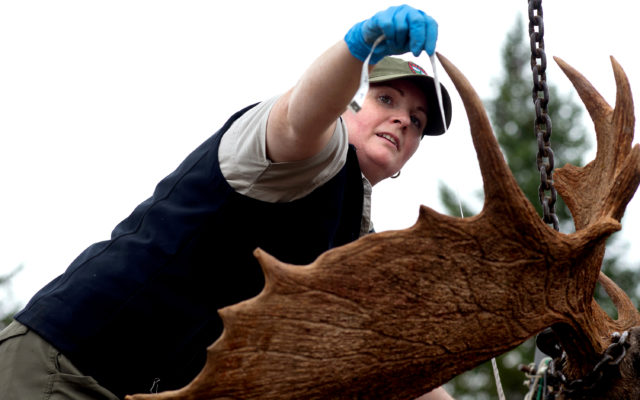
Last fall’s moose hunters enjoyed highest success rate since 2012
By John Holyoke, Bangor Daily News Outdoors Editor
Early season weather that was more fitting for a day at the beach than a Maine moose hunt didn’t slow the state’s hunters last fall. More than 76 percent of permitted hunters shot a moose, the highest success rate since 2012.
Lee Kantar, the moose biologist for the Maine Department of Inland Fisheries and Wildlife, spent the beginning of the September moose season at a tagging station in Fort Kent. He said that as the temperature rose, he expected hunters to have a tougher time finding moose, which were less likely to be standing out in the open, in the hot sun.
“We spent at least two, maybe three days with unseasonably warm temperatures. That was really frustrating — temperatures in the 80s in Fort Kent,” Kantar said. “I was kind of hoping that fewer moose would come in [to the tagging station], due to the temperatures and the lack of people’s preparation for that incredible heat. And yet, a ton of moose [were registered].”
In all, 2,382 of the 3,135 licensed hunters killed moose in 2020.
The state’s moose hunt is broken up into different seasons, with hunters assigned to a particular Wildlife Management District during a specific time frame. The 2020 hunt consisted of four different seasons, with a total of 3,135 permits allotted. Maine hunters received 90 percent of those permits, while nonresidents received 10 percent.
Kantar said a familiar pattern played out, with spots with higher moose population densities providing the best opportunities for hunters, despite the warmer-than-desired weather.
“I’m not sure there was any different story when we look at 2020 versus any other years,” Kantar said. “District 9, which is on the east side of Moosehead, had a very successful season in October. Here and there there are some very high success rates, and some that were not that high.”
Hunters enjoyed productive moose hunts despite another potential challenge, according to Kantar. Last year, after a new law was passed, early moose hunters had to share the woods with upland bird hunters.
“We had that earlier bird season that coincided with the moose hunt [in late September], and that presented some challenges on top of the fact that we’re living in the COVID world, so we’ve had an increase in hunters,” Kantar said. “It increased the potential for conflict, because there’s only so much land out there to hunt on.”
Statistically, however, the increased number of different hunting groups in the woods didn’t seem to hurt the moose hunting much.
The most successful era of Maine’s modern moose hunt stretched from 1988 until 1998. In 10 of those 11 years, more than 90 percent of licensed hunters filled their moose tags. The all-time record for hunter success came in 1991, when 959 of 1,000 moose permits (95.9 percent) were filled.
The success rate has not topped 90 percent since 1998, when 93.3 percent of hunters filled their tags. The lowest success rate came in 2014, when just 65.3 percent of hunters shot a moose.
Still, moose hunters are much more apt to experience a successful hunt than those that target other species. The DIF&W says the success rate of those hunting deer, bear or wild turkeys in Maine range historically from 18 to 30 percent.
“There are a lot of moose hunters who understand that those success rates are phenomenally high for a big game animal, when you compare that to rates [for other animals] across the United States,” Kantar said.
Kantar said hunters in certain northerly zones tend to do better than those in more southerly Wildlife Management Districts where moose are less plentiful. But even in those zones closer to the central part of the state, the success rate often tops 60 percent. Moose hunting is largely confined to the northern half of the state, with more permits allotted in areas with more moose.
Maine’s modern moose hunt was first staged in 1980 on an experimental basis. After a one-year hiatus, the hunt returned in 1982 and has been held annually ever since. The DIF&W holds a permit lottery each year to determine which hunters will win permits. After having their names drawn in the lottery, a hunter is required to sit out the next three drawings before he or she can win another permit.